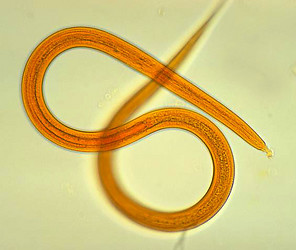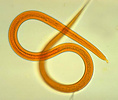Nematoda
Roundworms



This tree diagram shows the relationships between several groups of organisms.
The root of the current tree connects the organisms featured in this tree to their containing group and the rest of the Tree of Life. The basal branching point in the tree represents the ancestor of the other groups in the tree. This ancestor diversified over time into several descendent subgroups, which are represented as internal nodes and terminal taxa to the right.

You can click on the root to travel down the Tree of Life all the way to the root of all Life, and you can click on the names of descendent subgroups to travel up the Tree of Life all the way to individual species.
For more information on ToL tree formatting, please see Interpreting the Tree or Classification. To learn more about phylogenetic trees, please visit our Phylogenetic Biology pages.
close boxReferences
Aleshin, V. V., O. S. Kedrova, I. A. Milyutina, N. S. Vladychenskaya, and N. B. Petrov. 1998. Relationships among nematodes based on the analysis of 18S rRNA gene sequences: molecular evidence for monophyly of chromadorian and secernentian nematodes. Russian Journal of Nematology 6:175-184.
Aleshin, V. V., O. S. Kedrova, I. A. Milyutina, N. S. Vladychenskaya, and N. B. Petrov. 1998. Secondary structure of some elements of 18S rRNA suggests that strongylid and a part of rhabditid nematodes are monophyletic. FEBS-Letters 429:4-8.
Bird, A. F. and J. Bird. 1991. The Structure of Nematodes. Academic Press, San Diego, pp. 316.
Blaxter, M. L., P. De Ley, J. R. Garey, L. X. Liu, P. Scheldeman, A. Vierstraete, J. R. Vanfleteren, L. Y. Mackey, M. Dorris, L. M. Frisse, J. T. Vida, and W. K. Thomas. 1998. A molecular evolutionary framework for the phylum Nematoda. Nature 392:71-75.
Blaxter, M. L., M. Dorris and P. De Ley. 2000. Patterns and processes in the evolution of animal parasitic nematodes. Nematology 2:43-55.
Blouin, M. S., C. A. Yowell, C. H. Courtney, and J. B. Dame. 1998. Substitution bias, rapid saturation, and the use of mtDNA for nematode systematics. Molecular Biology and Evolution 15:1719-1727.
de Ley, P. 2000. Lost in worm space: phylogeny and morphology as road maps to nematode diversity. Nematology 2:9-16.
Dorris, M., P. De Ley, and M. L. Blaxter. 1999. Molecular analysis of nematode diversity and the evolution of parasitism. Parasitology Today 15:188-193.
Hodda, M. 2007. Phylum Nematoda. Pages 265-293 in: Zhang, Z.-Q. & Shear, W.A., eds. Linnaeus Tercentenary: Progress in Invertebrate Taxonomy. Zootaxa 1668:1-766.
Holterman, M., A. van der Wurff, S. van den Elsen, H. van Megen, T. Bongers, O. Holovachov, J. Bakker, and J. Helder. 2006. Phylum-wide analysis of SSU rDNA reveals deep phylogenetic relationships among nematodes and accelerated evolution toward crown clades. Molecular Biology and Evolution 23(9):1792-1800.
Kampfer, S., C. Sturmbauer, and J. Ott. 1998. Phylogenetic analysis of rDNA sequences from adenophorean nematodes and implications for the Adenophorea-Secernentea controversy. Invertebrate Biology 117:29-36.
Litvaitis, M. K., J. W. Bates, W. D. Hope, and T. Moens. 2000. Inferring a classification of the Adenophorea (Nematoda) from nucleotide sequences of the D3 expansion segment (26/28S rDNA). Canadian Journal of Zoology 78:911-922.
Lorenzen, S. 1994. The Phylogenetic Systematics of Free-Living Nematodes. The Ray Society, London.
Malakhov, V. V. 1994. Nematodes. Structure, Development, Classification and Phylogeny. Smithsonian Institution Press, Washington, D. C.
Meldal, B. H. M. , N. J. Debenham, P. De Ley, I. Tandingan De Ley, J. R. Vanfleteren, A. R. Vierstraete, W. Bert, G. Borgonie, T. Moens, P. A. Tyler, M. C. Austen, M. L. Blaxter, A. D. Rogers and P. J. D. Lambshead. 2007. An improved molecular phylogeny of the Nematoda with special emphasis on marine taxa. Molecular Phylogenetics and Evolution 42(3):622-636.
Nadler, S. A., P. De Ley, M. Mundo-Ocampo, A. B. Smythe, S. P. Stock, D. Bumbarger, B. J. Adams, I. Tandingan De Ley, O. Holovachov and J.G. Baldwin. 2006. Phylogeny of Cephalobina (Nematoda): Molecular evidence for recurrent evolution of probolae and incongruence with traditional classifications. Molecular Phylogenetics and Evolution 40(3):696-711.
Nielsen, C. 1998. Systematics - Sequences lead to tree of worms. Nature 392:25-26.
Poinar, G. O. 1983. The Natural History of Nematodes. Prentice Hall, Englewood Cliffs, NJ.
Powers, T. O., T. C. Todd, A. M. Burnell, P. C. B. Murray, C. C. Fleming, A. L. Szalanski, B. A. Adams, and T. S. Harris. 1997. The rDNA internal transcribed spacer region as a taxonomic marker for nematodes. Journal of Nematology 29:441-450.
Sommer, R. J., C. B. Sigrist, K. Grandien, B. Jungblut, A. Eizinger, H. Adamis, and I. Schlak. 1999. A phylogenetic interpretation of nematode vulval variations. Invertebrate Reproduction & Development 36:57-65.
Stone, A. R., H. M. Platt, and L. F. Khalil (eds.) 1983. Concepts in Nematode Systematics. Systematics Association special volume, no. 22. Academic Press, New York.
Voronov, D. A., Y. V. Panchin, and S. E. Spiridonov. 1998. Nematode phylogeny and embryology. Nature 395:28-28.
Wright, K. A. 1991. Nematoda. Pages 111–195 in: Microscopic Anatomy of Invertebrates, Vol. 4. F. W. Harrison and E. E. Ruppert, eds. Wiley-Liss, New York.
Information on the Internet
- Mark Blaxter's Nematode Genomics Lab.
- David Fitch Lab. New York University.
- NemAToL. W.Kelley Thomas's laboratory at University of New Hampshire.
- Nematode Net. Genome Sequencing Center, Washington University.
- NEMBASE. Provides access to the publically available nematode sequence and functional data.
- Nematode Genome Databases. UK Human Genome Mapping Project Resource Centre.
- FilGenNet, the Filarial Genome Network. An international initiative to coordinate genome research on the filarial nematode parasites of humans. Curated by Mark Blaxter.
- Wormatlas. A database of behavioral and structural anatomy of Caenorhabtidis elegans.
- WormBase. The Genome and Biology of Caenorhabtidis elegans.
- Florida Nematology. University of Florida.
- Plant and Insect Parasitic Nematode Home Page. University of Nebraska.
- USDA Nematology Lab Home Page.
- Plant-Parasitic Nematodes in Oregon Agriculture. Kathy Merrifield and Ben Muir. Includes The Nematode Songbook.
- The Darwin Nematode Project. Nematode biodiversity and worldwide pollution monitoring. Plymouth Marine Laboratory and Natural History Museum, London.
- Deep-Sea Nematodes. An environmental quality project at the Natural History Museum London.
- Society of Nematologists
Title Illustrations

| Scientific Name | Strongyloides |
|---|---|
| Creator | CDC/Dr. Mae Melvin |
| Life Cycle Stage | filariform larva |
| Source Collection | Public Health Image Library (Centers for Disease Control) |
About This Page
Page copyright © 2002
 Page: Tree of Life
Nematoda. Roundworms.
The TEXT of this page is licensed under the
Creative Commons Attribution-NonCommercial License - Version 3.0. Note that images and other media
featured on this page are each governed by their own license, and they may or may not be available
for reuse. Click on an image or a media link to access the media data window, which provides the
relevant licensing information. For the general terms and conditions of ToL material reuse and
redistribution, please see the Tree of Life Copyright
Policies.
Page: Tree of Life
Nematoda. Roundworms.
The TEXT of this page is licensed under the
Creative Commons Attribution-NonCommercial License - Version 3.0. Note that images and other media
featured on this page are each governed by their own license, and they may or may not be available
for reuse. Click on an image or a media link to access the media data window, which provides the
relevant licensing information. For the general terms and conditions of ToL material reuse and
redistribution, please see the Tree of Life Copyright
Policies.
Citing this page:
Tree of Life Web Project. 2002. Nematoda. Roundworms. Version 01 January 2002 (temporary). http://tolweb.org/Nematoda/2472/2002.01.01 in The Tree of Life Web Project, http://tolweb.org/








 Go to quick links
Go to quick search
Go to navigation for this section of the ToL site
Go to detailed links for the ToL site
Go to quick links
Go to quick search
Go to navigation for this section of the ToL site
Go to detailed links for the ToL site